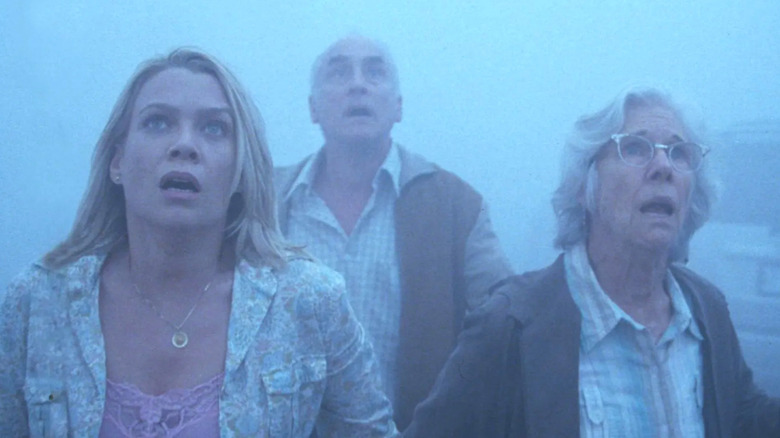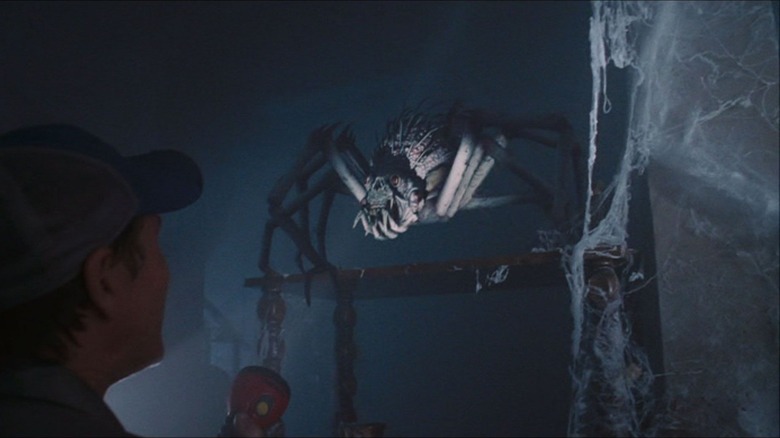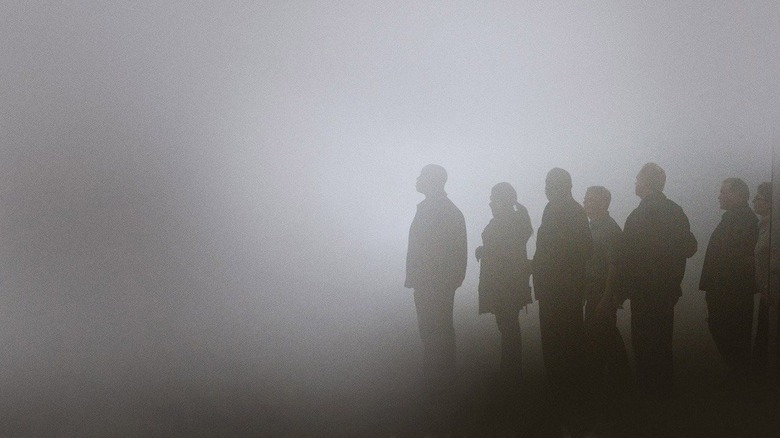Before It Was A Frank Darabont Movie, Stephen King's The Mist Was A 1984 Audio Drama
Stephen King's novella "The Mist" was originally published in 1980 as part of a horror compilation called "Dark Forces." The impressive compilation included stories by Ray Bradbury, Edward Gorey, Joyce Carol Oates, and Robert Bloch, along with several others. "Dark Forces" was notable in the horror community, and it was widely read by other horror authors. In the 1985 interview book "Faces of Fear," Clive Barker noted "Dark Forces" as the push he needed to start writing his own "Books of Blood."
"The Mist" was easily the standout of the compilation, and would eventually be adapted to film in 2007 by Frank Darabont. The film, like the novella, tells the story of a mysterious fog that rolls in across a small, rural community, cutting off all visibility. Hiding in the mist are unseen creatures. Enormous bugs and land octopodes appear from nowhere and attack the locals. The bulk of Darabont's film takes place in a locked grocery store with the customers hiding out from the beasties outside. Before long, factions form in the grocery store, and the humans turn on each other. Eventually, the monsters outside become preferable to the religious zealots inside. The film ends on a deliciously bleak note.
Why Darabont elected to adapt "The Mist" to the big screen is a bit of a baffling choice, as a complete lack of visibility is the story's central theme. While Darabont did manage to throw in some creepy visuals of tentacles emerging from a while, opaque sheet of fog, the fact that no one can see into it — that no one can see anything — is the primary source of the tale's terror. "The Mist" makes so much more sense on the page.
Or, as struck upon by the ZBS Foundation in 1984, when adapted for radio.
The ZBS Foundation
The ZBS Foundation was an audio drama collective that was formed in upstate New York in 1970 by a man named Thomas Manuel Lopez. Writing under the nom de plume of Meatball Fulton, Lopez sought to inject new life into the medium, feeling that — in the late 1960s and early 1970s — all the energy had drained from it. Based largely in New Age spirituality and a bearing healthy streak of skepticism toward the growing tide of commercialism, Lopez wrote a series of brilliant and striking works that starred full casts of charismatic actors and featured state-of-the-art sound effects and electronic music by Tim Clark. The ZBS Foundation is still in operation to this day. ZBS stands for "zero bull****."
The ZBS Foundation was briefly big business in the public radio world, and one could hear their programs on NPR throughout the 1980s. The shows featuring an intrepid-yet-naïve spiritual traveler Jack Flanders (Robert Lorick were at the forefront of the studio's catalog. I recommend "Moon Over Morocco." as were the sci-fi epics starring Ruby, the Galactic Gumshoe (Laura Esterman), who solved unusual consciousness-warping mysteries on the distant planet of Summa Nulla, long after the Earth had been bought by Disney. I recommend "Ruby 3" and "Ruby Four."
By 1984, ZBS — a known quantity now — had begun experimenting with new audio recording techniques. They discovered the wonderful world of the Kunstkopf binaural microphone, said to record programs in 3-D sound. The odd-looking binaural microphones were shaped like human heads, with recording devices located inside each of its human-shaped ears. Actors could move around the human head, recording their lines from various angles.
When listened to with headphones, it sounded like you were in the room. Hence the term "3-D sound."
The Mist, in 3-D sound
Using this new format, and operating with a license on a hot new Stephen King novella, the ZBS Foundation recorded an audio version of "The Mist" starring William Sadler in the lead role. Incidentally, Sadler would also appear in the 2007 feature film, although Thomas Jane took over the lead role.
In audio form, "The Mist" is fifty times more terrifying. As mentioned, not being able to see into the mist — gazing into an unknowable white cloud filled with unspeakable Lovecraftian horrors — is the crux of King's story. With the visual element removed, the fear remains. And, thanks to the deep sound of the binaural recording format, you can hear people, panicked, running around you. While Darabont did a wonderful job of making the mist itself seem scary, when you can't see it, the story is more effective. Additionally, director Bill Raymond (a ZBS regular) directed the show to have a lot more overlapping dialogue, with some portions of the scene playing close to a listener's ears, and others taking place over in the corner. To employ an overused critical buzzword, it is an immersive experience.
According to the 2014 book "Stephen King Films FAQ: All That's Left To Know About the King of Horror on Film" by Scott Von Doviak, Lopez adapted the audio script for "The Mist" from an unproduced screenplay written by horror author Dennis Etchison, who was in talks to make a film of "The Mist" for the legendary Dino DeLaurentiis. Cursory internet reasearch does not reveal the reason why this version wasn't made.
The original show was broadcast in three chapters, although the readily-available downloadable version has been mixed into a single show.
Darabont's film is good, but the ZBS version is near perfect.


